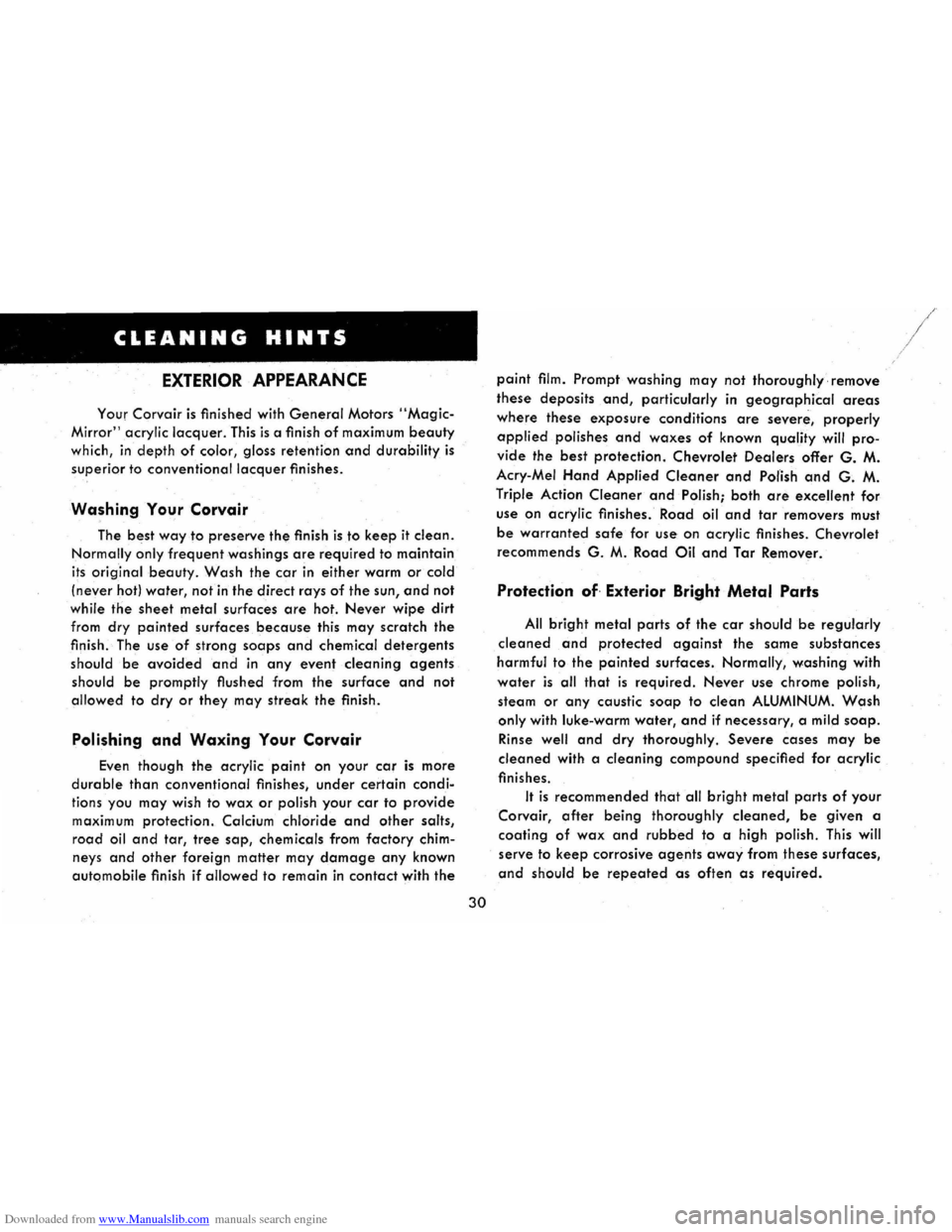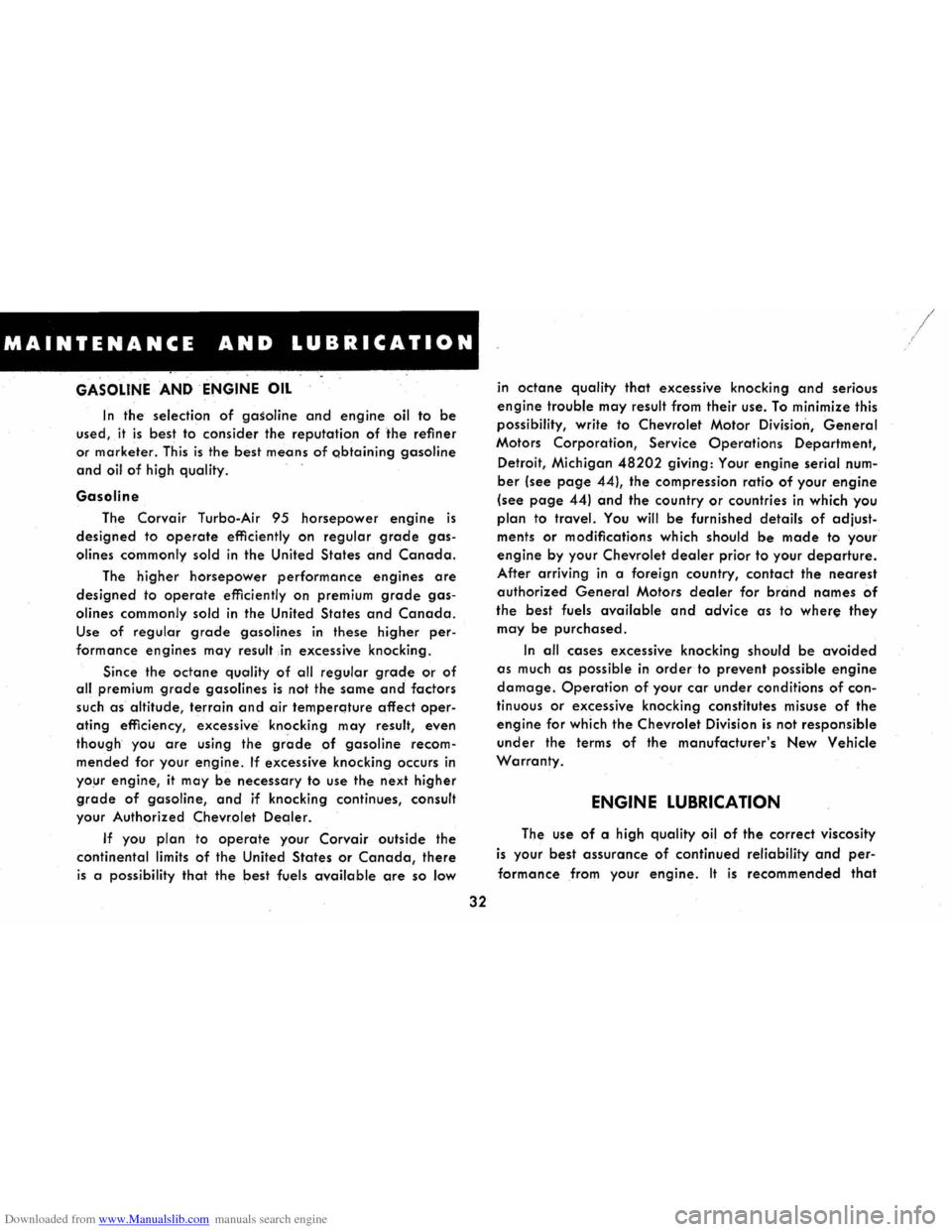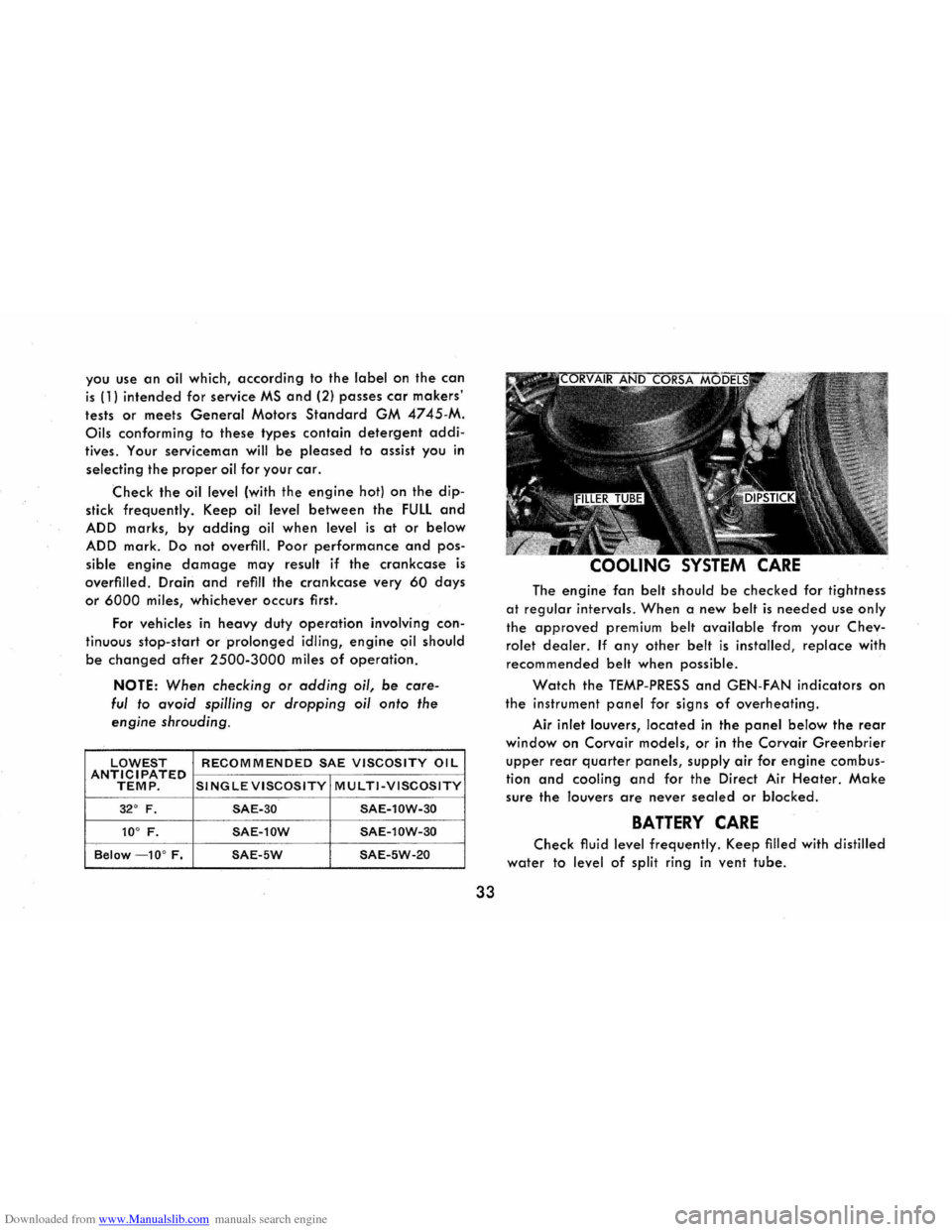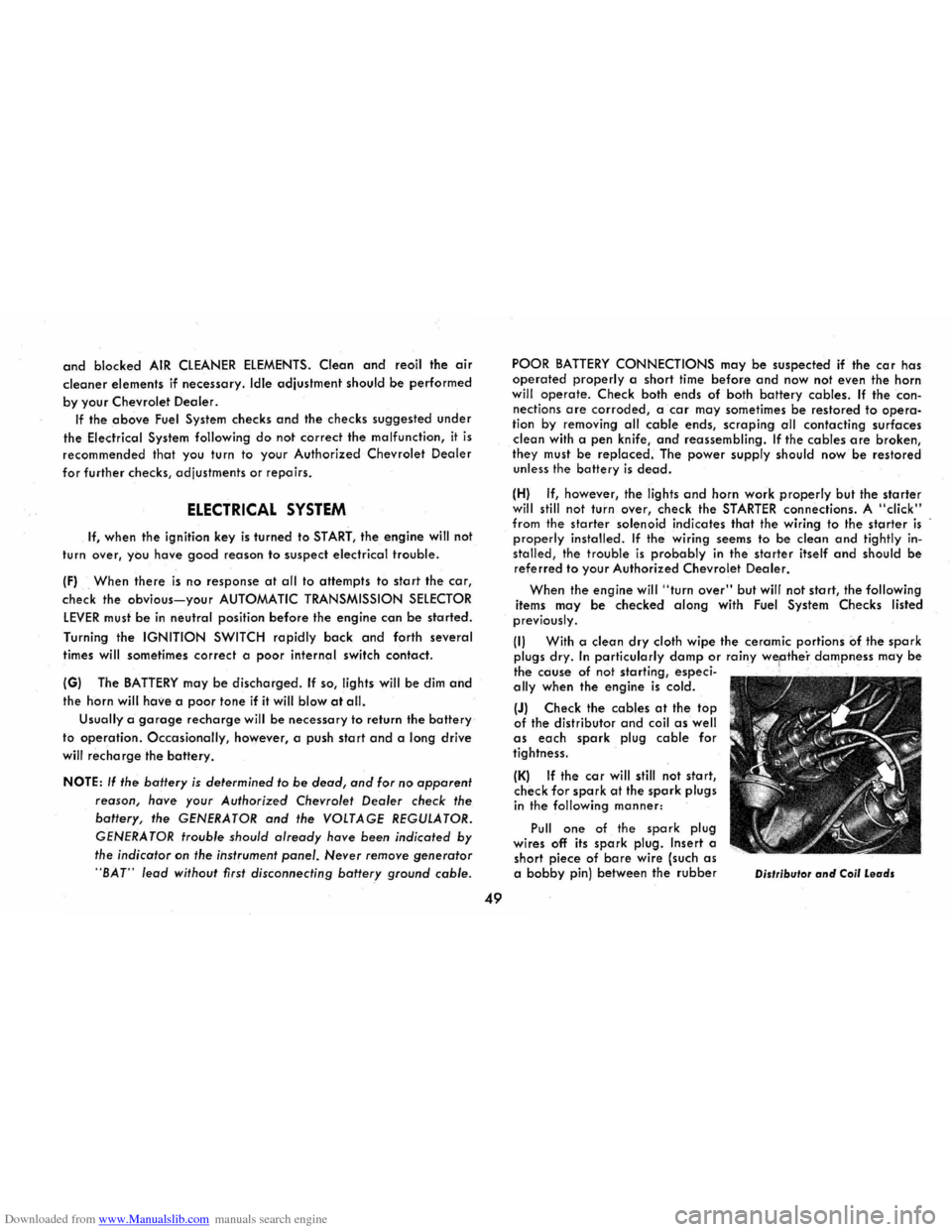recommended oil CHEVROLET CORVAIR 1965 2.G Owners Manual
[x] Cancel search | Manufacturer: CHEVROLET, Model Year: 1965, Model line: CORVAIR, Model: CHEVROLET CORVAIR 1965 2.GPages: 56, PDF Size: 22.29 MB
Page 33 of 56

Downloaded from www.Manualslib.com manuals search engine CLEANING HINTS
EXTERIOR APPEARANCE
Your Corvair is finished with General Motors "Magic
Mirror" acrylic lacquer. This is a finish of maximum beauty
which, in depth of color, gloss retention and durability is
superior to conventional lacquer finishes.
Washing Your Corvair
The best way to preserve the finish is to keep it clean.
Normally only frequent washings are required to maintain
its original beauty. Wash the car in either warm or cold
(never hot) water, not in the direct rays of the sun, and not
while the sheet metal surfaces are hot. Never wipe dirt
from dry painted surfaces because this may scratch the
finish. The use
of strong soaps and chemical detergents
should be avoided and in any event cleaning agents
should be promptly flushed from the surface and not
allowed to dry or they may streak the finish.
Polishing and Waxing Your Corvair
Even though the acrylic paint on your car is more
durable than conventional finishes; under certain condi
tions you may wish to wax or polish your car to provide
maximum protection. Calcium chloride and other salts,
road oil and tar, tree sap, chemicals from factory chim
neys
and other foreign matter may damage any known
automobile finish if allowed to remain in contact with the
30
paint film. Prompt washing may not thoroughly remove
these deposits .
and, particularly in geographical areas
where these exposure conditions are severe, properly
applied polishes and waxes of known quality will pro
vide the best protection. Chevrolet Dealers offer G. M.
Acry-Mel Hand Applied Cleaner and Polish and G. M.
Triple Action Cleaner and Polish; both are excellent for
use on acrylic finishes. Road oil and tar removers must
be warranted safe for use on acrylic finishes. Chevrolet
recommends G. M. Road Oil and Tar Remover.
Protection of. Exterior Bright Metal Parts
All bright metal parts of the car should be regularly
cleaned and protected against the same substances
harmful to the painted surfaces. NormallY, washing with
water is all that is required. Never use chrome polish,
steam or any caustic soap to clean ALUMINUM. Wash
only with luke-warm water, and if necessary, a mild soap.
Rinse well and dry thoroughly. Severe cases may be
cleaned with a cleaning compound specified for acrylic
finishes.
It is recommended that all bright metal parts of your
Corvair, after being thoroughly cleaned, be given a
coating of wax and rubbed to a high polish. This will
serve to keep corrosive agents away from these surfaces,
and should be repeated as often as required.
Page 35 of 56

Downloaded from www.Manualslib.com manuals search engine MAINTENANCE AND LUBRICATION
GASOLINE AND ENGINE OIL
In the selection of gasoline and engine oil to be
used, it is best to consider the reputation of the refiner
or marketer. This is the best means of obtaining gasoline
and oil of high quality.
Gasoline
The Corvair Turbo-Air 95 horsepower engine is
designed to operate efficiently on regular grade gas
olines commonly sold in the United States and Canada.
The
higher horsepower performance engines are
designed to operate efficiently on premium grade gas
olines commonly sold in the United States and Canada.
Use of regular grade gasolines in these higher per
formance engines may result ,in excessive knocking.
Since the octane quality of all regular grade or of
all premium grade gasolines is not the same and factors
such as altitude, terrain and air temperqture affect oper
ating efficiency, excessive' knocking may result, even
though you are using the grade of gasoline recom
mended for your engine. If excessive knocking occurs in
your engine, it may be necessary to use the next higher
grade of gasoline, and if knocking continues, consult
your Authorized Chevrolet Dealer.
If you plan to operate your Corvair outside the
continental limits of the United States or Canada, there
is a possibility that the best fuels available are so low
32
in octane quality that excessive knocking and serious
engine trouble may result from their use. To minimize this
possibility, write to Chevrolet Motor Division, General
Motors Corporation, Service Operations Department,
Detroit, Michigan 48202 giving: Your engine serial num
ber (see page 44), the compression ratio of your engine
(see page 44) and the country or countries in which you
plan to travel. You will be furnished details of adjust
ments or modifications which should be made to your
engine by your Chevrolet dealer prior to your departure.
After arriving in a foreign country, contact the nearest
authorized General Motors dealer for brand names of
the best fuels available and advice as to where they
may be purchased.
In all cases excessive knocking should be avoided
as much as possible in order to prevent possible engine
damage. Operation of your car under conditions of con
tinuous or excessive knocking constitutes misuse of the
engine for which the Chevrolet Division is not responsible
under the terms of the manufacturer's New Vehicle
Warranty.
ENGINE LUBRICATION
The use of a high quality oil of the correct viscosity
is your best assurance of continued reliability and per
formancefrom your engine. It is recommended that
/ /
Page 36 of 56

Downloaded from www.Manualslib.com manuals search engine you use an oil which, according to the label on the can
is (1) intended for service MS and (2) passes car makers'
tests or meets General Motors Standard GM 4745-M .
Oils conforming to these types contain detergent addi
tives. Your serviceman will be pleased to assist you in
selecting the proper oil for your car.
Check the oil level (with the engine hot) on the dip
stick frequently. Keep oil level between the FULL and
ADD marks, by adding oil when level is at or below
ADD mark. Do not overfill. Poor performance and pos
sible engine damage may result if the crankcase is
overfilled. Drain and refill the crankcase very 60 days
or 6000 miles, whichever occurs first.
For vehicles
in heavy duty operation involving con
tinuous stop-
start or prolonged idling, engine oil should
be changed after 2500-3000 miles of operation.
NOTE: When checking or adding oil, be care
ful to avoid spilling or dropping oil onto the
engine shrouding.
LOWEST RECOMMENDED SAE VISCOSITY OIL ANTICIPATED TEMP. SINGLE VISCOSITY MULTI-VISCOSITY
32° F. SAE-30 SAE-l0W-30
10° F. SAE-l0W SAE-l0W-30
Below -10° F. SAE-5W SAE-5W-20
33
COOLING SYSTEM CARE
The engine fan belt should be checked for tightness
at regular intervals. When a new belt is needed use only
the approved premium belt available from your Chev
rolet dealer. If any other belt is installed, replace with
recommended belt when possible .
Watch the TEMP-PRESS and GEN-FAN indicators on
the instrument panel for signs of overheating.
Air inlet louvers, located in the panel below the rear
window on Corvair models, or in the Corvair Greenbrier
upper rear quarter panels, supply air for engine combus
tion
and cooling and for the Direct Air Heater. Make
sure the louvers are never sealed or blocked.
BATTERY CARE
Check fluid level frequently. Keep filled with distilled
water to level of split ring in vent tube.
Page 52 of 56

Downloaded from www.Manualslib.com manuals search engine and blocked AIR CLEANER ELEMENTS. Clean and reoil the air
cleaner elements if necessary. Idle adjustment should be performed
by your Chevrolet Dealer.
If the above Fuel System checks and the checks suggested under
the Electrical System following do not correct the malfunction, it is
recommended that you turn to your Authorized Chevrolet Dealer
for further checks , adjustments or repairs.
ELECTRICAL SYSTEM
If, when the ignition key is turned to START, the engine will not
turn
over, you have good reason to suspect electrical trouble.
(F) When there .is no response at all to attempts to start the car,
check the obvious-your AUTOMATIC TRANSMISSION SElECTOR
LEVER must be in neutral position before the engine can be started.
Turning the IGNITION SWITCH rapidly back and forth several
times will sometimes correct a poor internal switch contact.
(G) The
BATTERY may be discharged. If so, lights will be dim and
the horn will have a poor tone if it will blow at all.
Usually a
garage recharge will be necessary to return the battery
to operation. Occasionally, however , a push start and a long drive
will
recharge the battery.
NOTE : If the battery is determined to be dead, and for no apparent
reason , have your Authorized Chevrolet Dealer check the
battery, the GENERATOR and the VOLTAGE REGULATOR .
GENERA TOR trouble should already have been indicated by
the indicator on the instrument panel. Never remove generator
"BAT" lead without first disconnecting battery ground cable.
49
POOR BATTERY CONNECTIONS may be suspected if the car has operated properly a short time before and now not even the horn
will operate. Check both ends of both battery cables. If the con
nections are corroded, a car may sometimes be restored to opera
tion by removing all cable ends, scraping all contacting surfaces clean with a pen knife , and reassembling . If the cables are broken, they must be replaced. The power supply should now be restored unless the battery is dead.
(H) If, however, the lights and horn work properly but the starter will still not turn over, check the STARTER connections. A "click" from the starter solenoid indicates that the wiring to the starter is properly installed . If the wiring seems to be clean and tightly installed, the trouble is probably in the starter itself and should be referred to your Authorized Chevrolet Dealer.
When the engine will "turn over" but will not start, the following
items may be checked along with Fuel System Checks listed
previously .
(I) With a clean dry cloth wipe the ceramic portions of the spark plugs dry. In particularly damp or rainy wellthe'r dampness may be the cause of not starting, especi-: . ally when the engine is cold.
(J) Check the cables at the top of the distributor and coil as well as each spark plug cable for tightness.
(K) If the car will still not start, check for spark at the spark plugs in the following manner:
Pull
one of the spark plug
wires off its spark plug. Insert a
short piece of bare wire (such as a bobby pin) between the rubber Oislribulor and Coil Leads